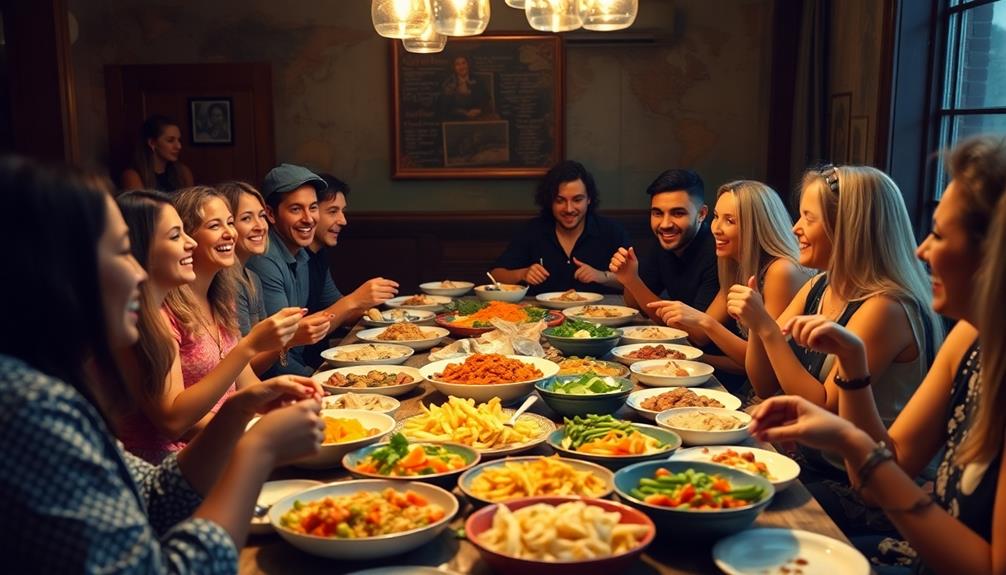Different cultures use food as social currency to build connections and express identity. When you share meals, you foster trust and deepen relationships. In many traditions, inviting someone to dine symbolizes warmth and hospitality. You might notice that what's on the table often reflects historical narratives and cultural pride, like Tamales during celebrations or coffee in Middle Eastern gatherings. Food can also indicate status, showcasing wealth through elaborate dining experiences. This exchange enriches communal ties, often blurring social hierarchies. If you're curious about how these practices shape our interactions and traditions, there's more to discover about the cultural significance of food.
Key Takeaways
- Shared meals foster trust, kinship, and social bonds, acting as a medium for cultural exchange and diplomacy.
- Food acts as a status symbol, reflecting wealth and social standing through high-end dining experiences and elaborate meals.
- Hospitality traditions, such as offering coffee or traditional dishes, signify respect and promote social interaction among cultures.
- Culinary rituals and celebrations, like Mexican Día de los Muertos, reinforce cultural identity and community ties through traditional foods.
- Globalization influences food culture by facilitating ingredient exchange, but risks erasing historical significance and authenticity of traditional cuisines.
The Role of Shared Meals

Shared meals create a powerful environment for building trust and connection among people. When you gather around a table with others, you're not just sharing food; you're also sharing experiences and fostering relationships. In many cultures, shared meals are essential for establishing kinship and social bonds.
For example, during the Pacific Theater, American servicemen used food as a form of currency, bartering meals and rations to strengthen camaraderie among peers. In Brazilian culture, communal dining is particularly important, as dishes like Caldeirada exemplify the rich flavors and cultural exchange that occur when people come together to enjoy traditional meals.
Cultural exchange flourishes during shared meals, as diverse culinary practices come together, allowing you to appreciate different traditions and flavors. This act of sharing food isn't limited to casual gatherings; it's deeply embedded in celebrations and community events, emphasizing connection and inclusivity.
Moreover, shared meals have historically served as a medium for diplomacy and conflict resolution. When you sit down to break bread with someone from a different background, it creates a space for dialogue and understanding, transcending social and economic barriers.
Ultimately, these communal dining experiences highlight the importance of trust and cooperation, making shared meals a cornerstone of social interaction across various cultures.
Food and Hospitality Traditions

Food often plays an essential role in hospitality traditions around the world, transforming simple gatherings into meaningful exchanges. In many cultures, sharing food during communal meals or feasts creates social bonds and strengthens community ties.
For instance, in Pacific Islander cultures, the preparation and sharing of traditional dishes help build trust and kinship between hosts and guests. In Lebanese culture, the act of serving dishes like Kawarma (Preserved Meat) to guests isn't just about the food itself; it represents generosity and a warm welcome, deepening social connections.
Breaking bread together, a practice rooted in various religious and cultural contexts, symbolizes unity and belonging, often transcending social hierarchies. In Middle Eastern cultures, offering coffee or tea isn't just a gesture; it embodies respect and generosity while promoting social interaction.
Similarly, in Latin American cultures, inviting someone to share a meal signifies an open door, reinforcing personal relationships and connections.
These hospitality traditions illustrate how food operates within a broader food system, serving as a vehicle for social exchange and cultural expression. By participating in these rituals, you engage with the values and norms of different cultures, enriching your understanding of human connections.
Ultimately, food becomes more than sustenance; it's a crucial part of building relationships and fostering community.
Celebrating Cultural Identity

When you gather around the table for a traditional feast, you're not just sharing food; you're celebrating your cultural identity. Each dish tells a story, connecting you to your heritage and the people who came before you.
For instance, dishes like Chilaquiles and Tamales aren't only delicious but also represent the creativity and resourcefulness of various cultures. These shared meals and customs strengthen bonds within your community and keep your traditions alive.
Food as Identity Marker
Cultural identity often unfolds through the flavors and dishes that define a community. Food acts as a powerful identity marker, embodying historical narratives and regional customs unique to your culture. Each bite tells a story, whether it’s the spices used in a traditional recipe or the cooking techniques passed down through generations. Moreover, cultural perspectives on dessert reveal even deeper insights into the values and traditions of a community. Sweet treats often serve as symbols of celebration, connection, and memory, bridging gaps between generations and fostering a sense of belonging. As people gather around the table to savor these delicacies, they not only indulge their taste buds but also share in the collective history and identity that food represents.
For instance, dishes like Dorayaki (Red Bean Pancake) and Umeboshi (Pickled Plum) highlight how traditional sweets and pickles play a role in Japanese culture, symbolizing both heritage and comfort.
Festivals and communal meals, like the Mexican Día de los Muertos, showcase this connection. Here, traditional foods reinforce cultural ties and let you express your heritage through culinary practices. In many cultures, specific food items symbolize more than sustenance. Take the cacao beans in Maya civilization, for instance; they weren't just currency but also represented sacredness and social status.
You might notice that cultural identities evolve with modern values, too. The rise of vegetarianism and veganism among millennials illustrates how food choices often reflect ethical beliefs tied to environmental sustainability.
While globalization may commercialize traditional cuisines, immigrant communities endeavor to maintain authenticity by preserving original recipes and cooking methods. This dedication allows you to celebrate your cultural heritage and keep your identity alive through the food you cherish.
Shared Meals and Traditions
Shared meals create a unique space where cultural identities come alive, allowing people to connect over familiar flavors and cherished traditions. For instance, traditional dishes like Agnolotti from Northern Italy showcase regional culinary skills and foster a sense of belonging.
These gatherings not only nourish the body but also serve as essential expressions of heritage, fostering kinship and trust among diverse communities. Through shared meals, you can experience the richness of different cultures while reinforcing community ties.
Consider these key aspects of shared meals and traditions:
- Communal Dining: Practices like potlucks and feasts encourage the sharing of traditional dishes, celebrating cultural identity.
- Symbolic Foods: Certain ingredients, such as cacao beans in Maya culture, hold spiritual significance and bring people together.
- Cultural Festivals: Events like Diwali and Thanksgiving highlight the role of shared meals in maintaining cultural traditions and fostering belonging.
- Breaking Barriers: In military contexts, servicemen use shared meals to establish camaraderie, transcending rank and unit differences.
Food as Status Symbol

Food often acts as a powerful status symbol, reflecting not just personal taste but also wealth and social standing. When you indulge in high-end dining experiences featuring caviar or truffles, you're not just savoring unique flavors; you're signaling your position in society.
This concept extends to the rise of "foodies," especially among millennials, who showcase their culinary adventures on social media, intertwining their identities with exclusive dining experiences. Certain cuisines, like Japanese kaiseki or French haute cuisine, elevate meal presentation and preparation to an art form, making them coveted status symbols.
In Chinese culture, dishes such as Red-Braised Pork Belly are often reserved for special occasions, further underscoring their status as symbols of wealth and culinary appreciation. Choosing organic or locally sourced ingredients, on the other hand, conveys a commitment to sustainability and ethical consumption, further enhancing your social image.
Hosting elaborate meals or feasts allows you to display wealth and hospitality, reinforcing your social standing and community connections. You're not just sharing food; you're sharing an experience that highlights your taste and sophistication.
In today's world, what you eat can often speak volumes about who you are, making food as a status symbol a significant aspect of social interactions.
Community Bonding Through Cuisine

Meals bring people together, creating a sense of kinship and trust that strengthens community bonds. When you share food, you're not just nourishing your body; you're engaging in a powerful form of social currency. This shared experience fosters cooperation and reinforces connections among diverse groups.
Traditional dishes, such as Tella and Tej, often play an essential role in these gatherings, adding layers of cultural significance. Here are four ways community bonding through cuisine manifests:
- Shared Meals: Dining together blurs social hierarchies, encouraging interactions that deepen relationships.
- Food Gifts: Exchanging specific food items during communal events symbolizes respect and strengthens ties among participants.
- Culinary Practices: Community gatherings often revolve around traditional feasting, enhancing social cohesion and cultural identity.
- Empirical Benefits: Research shows that food sharing increases feelings of belonging, making communal dining a fundamental part of community engagement.
Food in Rituals and Celebrations

Rituals and celebrations often revolve around the culinary traditions that define a culture, showcasing how essential these practices are to community identity. Food serves as a powerful medium for connection, remembrance, and shared experiences.
Consider how various cultures incorporate food into their rituals:
| Culture | Rituals and Celebrations |
|---|---|
| Mexican | During Día de los Muertos, altars are adorned with favorite foods of deceased loved ones. |
| Jewish | The Passover Seder features symbolic foods like matzah, representing the hardships of the Exodus. |
| Indian | Weddings embrace large feasts, with regional dishes highlighting significant life events. |
In African communities, communal feasts during harvest festivals symbolize gratitude and strengthen relationships among members. Each of these rituals reinforces cultural identity, inviting you to share in a collective experience. As you partake in these meals, remember that you're not just enjoying food; you're participating in a tradition that connects you to history, family, and community. Through these shared culinary experiences, food becomes more than sustenance—it transforms into an essential thread in the fabric of social bonds.
The Impact of Globalization on Food Culture

In today's interconnected world, the impact of globalization on food culture is profound and multifaceted. You can see how this phenomenon reshapes your culinary landscape, influencing what and how you eat. For instance, the popularity of dishes like Mushroom Masala highlights how traditional vegetarian options can transcend borders and appeal to a global audience.
Here are four key effects of globalization on food culture:
- Ingredient Exchange: Globalization allows for the introduction of ingredients from one region to another, like potatoes from the New World transforming European cuisines.
- Commercialization and Simplification: The global market often dilutes authentic flavors, leading to simplified versions of traditional dishes, such as tacos or burritos, that overlook their rich regional diversity.
- Cultural Erasure: When cuisines are commercialized without context, you risk losing the historical significance of traditional dishes, diminishing their value and understanding.
- Authenticity Concerns: With many foreign food establishments run by non-native operators, like 85% of Japanese restaurants in New York City, you may question the authenticity and integrity of the cuisines being served.
As globalization continues to shape your food culture, it's crucial to appreciate the depth and diversity of culinary heritages while recognizing the challenges posed by commercialization and cultural dilution.
Frequently Asked Questions
What Other Cultures Have Used as a Form of Money or Currency?
You might find that cultures like the Chinese used tea as currency, while in West Africa, cowries served as money. Similarly, the Native Americans traded wampum beads, showcasing diverse forms of value throughout history.
How Does Food Serve as a Form of Communication in Different Cultures?
Food communicates values and emotions in various cultures. When you share a meal, you express hospitality and connection. Each dish tells a story, conveying respect, love, or tradition, bridging gaps and fostering understanding among people.
Was Food Used as Currency?
Yes, food has historically served as currency. You'll find examples like cacao beans in Maya society and rice in Japan, showcasing how essential foods facilitated trade and economic transactions across various cultures and periods.
What Does Food Mean in Different Cultures?
Food embodies identity, tradition, and community in different cultures. You'll find it symbolizes love, celebration, and even mourning, reflecting shared values. Each dish tells a story, connecting you to history and the people around you.
Conclusion
In the tapestry of life, food weaves connections that transcend borders and beliefs. Each shared meal is like a thread, binding hearts and cultures together, reflecting our shared humanity. As you savor a dish, remember it's not just about taste; it's a symbol of hospitality, identity, and community. Embrace these flavors, for they tell stories of love and tradition, reminding us that, in the end, we're all nourished by the same universal hunger for belonging.










